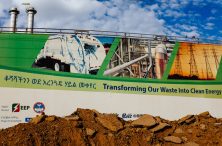The Reppie Waste-to-Energy Plant has started it’s operations in Addis Ababa, Ethiopia, reports Waste management World.
The plant whose construction began in 2014 is Africa’s first Waste-to-Energy facility. The project cost of the facility is estimated at 118 million US Dollars. This came into reality through a partnership deal signed by the Ethiopian government and the UK based Cambridge Industries.
[trend-ad-shortcode id=”4512″ title=”Leaderboard Google Adsense”]
The facility that is expected to generate consistent power was constructed by consortium made up of Cambridge Industries Limited (CIL) and China National Electric Engineering Co. Ltd (CNEEC) and is owned by the Ethiopian Electric Power (EEP). The plants is expected to substitute hydro-electric power when river flows are reduced due to seasonal or climatic changes.
Read Also: Ugandan Entrepreneur Makes Paper Bags From Banana Stalk
The Reppie facility is expected to process about 1400 tonnes of waste on a daily bases. The project , built to EU emissions standard will incinerate the city’s waste to generate about 50MW of electricity. This will add to the national electricity grid as well as replace the expensive diesel-powered power plants that are usually used to substitute for energy shortages.
[trend-ad-shortcode id=”4512″ title=”Leaderboard Google Adsense”]
The waste stream of Africa is considered to have a low caloric value and high moisture content. This is unique and different from what you find in Europe. The Consortium was put in place to design and construct (in some cases own) “extremely cost-competitive and scalable waste-to-energy facilities customized for Sub-Saharan Africa. The development of Reppie represents Phase I of a wider rollout program to develop multiple waste-to-energy plants across SSA’s major cities”. (Source)
Startup Idea: Starting A Cold Room Business in Africa
According to Ethiopia’s President, Mulatu Teshome, Ethiopia has been investing a lot in the green energy sector with key investments in hydro-power, wind energy, geothermal and lately, biomass to give a boost to the manufacturing sector.
The government in November 2011, launched a 150 billion US Dollar Climate Resilient Green Economy with objectives to make Ethiopia a middle-income economy as well as keeping greenhouse gas emissions at a constant low by the year 2025. In fact, the plant will convert the country into an “eco-friendly industrial powerhouse” according to The Guardian. It will also help reduce the solid waste in the city, making it beautiful as well as providing a source of income for many of the city’s young people.
Source(s): Cambridge Industries Ltd | Waste Management World
Image Source: Cambridge Industries Ltd
Discover more from OpenHub Digital
Subscribe to get the latest posts sent to your email.

